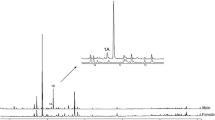Abstract
Laboratory and field investigations were carried out to characterize the chemical communication system of the date palm fruit stalk borer, Oryctes elegans, and to develop pheromone-based trapping in Eastern Iran. Adults of both sexes feeding on date palm pieces attracted conspecifics, whereas date palm alone was minimally attractive. Males were twice as attractive as females. More beetles were captured at the palm crown than at ground level. Odors from adults feeding on sugarcane were sampled and analyzed by gas chromatography and mass spectrometry. Whereas females did not emit sex specific volatiles, males emitted a blend of 4-methyloctanoic acid (1: major component) and ethyl 4−methyloctanoate (2), occasionally mixed with minor components: 4-methyloctanyl acetate (3), methyl 4-methyloctanoate (4), 4-methyloctanol (5), and nonanyl acetate (6). Electroantennography and field trapping experiments demonstrated that compound 1 is an essential component of the male aggregation pheromone of O. elegans. It was barely attractive by itself but synergistic with fresh date palm odor. It attracted many more beetles than any of compounds 2–6. The addition of one or several of compounds 2–6 to 1 did not improve trap captures. During the course of 2 years, we captured 4000 beetles, with a weekly average of 6.3 beetles/trap, and were able to monitor the seasonal flight of O. elegans. Our results provide the basis for developing mass trapping for control of this pest.
Similar content being viewed by others
REFERENCES
Alfiler, A. R. R. 1999. Increased attraction of Oryctes rhinoceros aggregation pheromone, ethyl 4-methyloctanoate, with coconut wood. Coconut Res. Dev. 15:131–149.
Bedford, G. O. 1980. Biology, ecology, and control of palm Rhinoceros beetles. Annu. Rev. Entomol. 25:309–339.
Chung, G. F. 1997. The bioefficacy of the aggregation pheromone in mass trapping of rhinoceros beetles (Oryctes rhinoceros L.) in Malaysia. The Planter (Kuala Lumpur) 73:119–127.
EndrÖdi, S., 1985. The Dynastinae of the World. Dr. W. Junk Publishers, the Hague, The Netherlands, ISBN 90-6193-138-X, Series Entomologica 28, 800pp.
EndrÖdi, S. and Petrovitz, R. 1974. Die Arten und Rassen der Gattung Oryctes Illiger in Iran. Entomol. Phytopathol. Appl. (Iran) 36:4–19.
Gharib, A. 1970. Oryctes elegans Prell. (Coleoptera—Dynastidae). Entomol. Phytopathol. Appl. (Iran) 29:10–12.
Giblin-Davis, R. M., Oehlschlager, A. C., Perez, A., Gries, G., Gries, R., Weissling, T. J., Chinchila, C. M., Pena, J. E., Hallet, R. H., Pierce, H. D. Jr., and Gonzalez, L. M., 1996. Chemical and behavioral ecology of palm weevils (Curculionidae: Rhynchophorinae). Fla. Entomol. 79:153–167.
Gries, G., Gries, R., Perez, A. L., Oehlschlager, A. C., Gonzalez, L. M., Pierce, H. D., Jr., Zebeyou, M., and Kouame, B. 1994. Aggregation pheromone of the African rhinoceros beetles, Oryctes monoceros (Olivier) (Coleoptera: Scarabaeidae). Z. Naturforsch. 49c:363–366.
Hallet, R. H., Perez, A. L., Gries, G., Gries, R., Pierce, H. D., Jr., Yue, J., Oehlschlager, A. C., Gonzalez, L. M., and Borden, J. H. 1995. Aggregation pheromone of the coconut rhinoceros beetles, Oryctes rhinoceros (L.) (Coleoptera: Scarabaeidae). J. Chem. Ecol. 21:1549–1570.
Ho, C. T. 1996. The integrated management of Oryctes rhinoceros (L.) populations in the zero burning environment, in Proceedings of the PORIM International Oil Palm Congress, Kuala Lumpur, Malaysia. pp. 336–368.
Hurpin, B. and Fresneau, M. 1969. Contribution à lëtude de Oryctes elegans [Col. Dynastinae]. Ann. Soc. Entomol. Fr. (N.S.) 5:595–612.
Hussain, A. A., 1974. Date Palms and Dates with Their Pests. University of Baghdad, Baghdad, Iraq, pp. 93–95.
Julia, J.-F and Mariau, D. 1976. Research on Oryctes monoceros Ol. in Ivory Coast. III. Olfactory trapping with ethyl chrysanthemate. Oléagineux 31:263–272.
Lepesme, P. 1947. Les insectes des palmiers. Paul Lechevalier, Paris, pp. 447–473.
Minitab, 1998. Statistical software, version 12.2 in French, Minitab Inc., France.
Morin, J.-P, Rochat, D., Malosse, C., Lettere, M., Desmier de Chenon, R., Wibwo, H., and Descoins, C. 1996. Ethyl-4-methyloctanoate, major component of Oryctes rhinoceros (L.) (Coleoptera, Dynastidae) pheromone. C.R. Acad. Sci. Paris, Life Sci. 319:595–602
Prior, R., Morin, J.-P, Rochat, D., Beaudoin-Ollivier, L., Stathers, T., Kakul, K., Embupa, S., and Nanguai, R. 2000. New aspects of the biology of the Melanesian rhinoceros beetle Scapanes australis (Col., Dynastidae) and evidence for field attraction to males. J. Appl. Entomol. 124:41–50.
Purba, R., Prawirosukarto, S., Desmier de Chenon, R., Morin, J.-P, and Rochat, D. 2000. Effect of Oryctes rhinoceros pheromone (ethyl 4-methyloctanoate) diffusion rate on the size of pest catches, in Proceedings of the XXIth International Congress of Entomology. Foz do Iguaçcuu, Brasil, August 20-26, 2000, Vol. I, p. 181.
Rochat, D., Morin, J.-P, Kakul, T., Beaudoin-Ollivier, L., Prior, R., Renou, M., Malosse, I., Stathers, T., Embupa, S., and Laup, S. 2002. Activity of male pheromone of the Melanesian rhinoceros beetle Scapanes australis. J. Chem. Ecol. 28:479–500.
Rochat, D., Nagnan-Le Meillour, P., Esteban-Duran, J. R., Malosse, C., Perthuis, B., Morin, J.-P, and Descoins, C. 2000a. Identification of pheromone synergists in American palm weevil, Rhynchophorus palmarum, and attraction of related Dynamis borassi (Coleoptera, Curculionidae). J. Chem. Ecol. 26:155–187.
Rochat, D., Ramirez-Lucas, P., Malosse, C., Aldana, R., Kakul, T., and Morin, J.-P. 2000b. Role of solid-phase microextraction in identification of highly volatile pheromones of two rhinoceros beetles Scapanes australis and Strategus aloeus (Coleoptera, Scarabaeidae, Dynastinae). J. Chrom. A 885:433–444.
Sudharto, P. S., Purba, R. Y., Rochat, D., and Morin, J.-P. 2001. Synergy between empty oil palm fruit bunch and synthetic aggregation pheromone (ethyl 4-methyloctanoate) for mass trapping of Oryctes rhinoceros beetles in the oil palm plantation in Indonesia, in Proceedings of the PORIM International Oil Palm Congress, Kuala Lumpur, Malaysia, pp. 661–664.
Vander Meer, R. K. and McGovern, T. P. 1983. Structure-activity correlations for derivatives of siglure: Attractants for Oryctes rhinoceros L. (Coleoptera: Scarabaeidae). J. Econ. Entomol. 76:723–727.
Vander Meer, R. K., Ghatak, U. R., Alam, S. K., and Chakraborti, P. C. 1979. (Plus or minus)-Des-N-morphinan: A unique bridged hydrocarbon attractant for the rhinoceros beetle, Oryctes rhinoceros, and development of an olfactometer. Environ. Entomol. 8:16–10.
Author information
Authors and Affiliations
Corresponding author
Rights and permissions
About this article
Cite this article
Rochat, D., Mohammadpoor, K., Malosse, C. et al. Male Aggregation Pheromone of Date Palm Fruit Stalk Borer Oryctes elegans . J Chem Ecol 30, 387–407 (2004). https://doi.org/10.1023/B:JOEC.0000017984.26917.52
Issue Date:
DOI: https://doi.org/10.1023/B:JOEC.0000017984.26917.52




